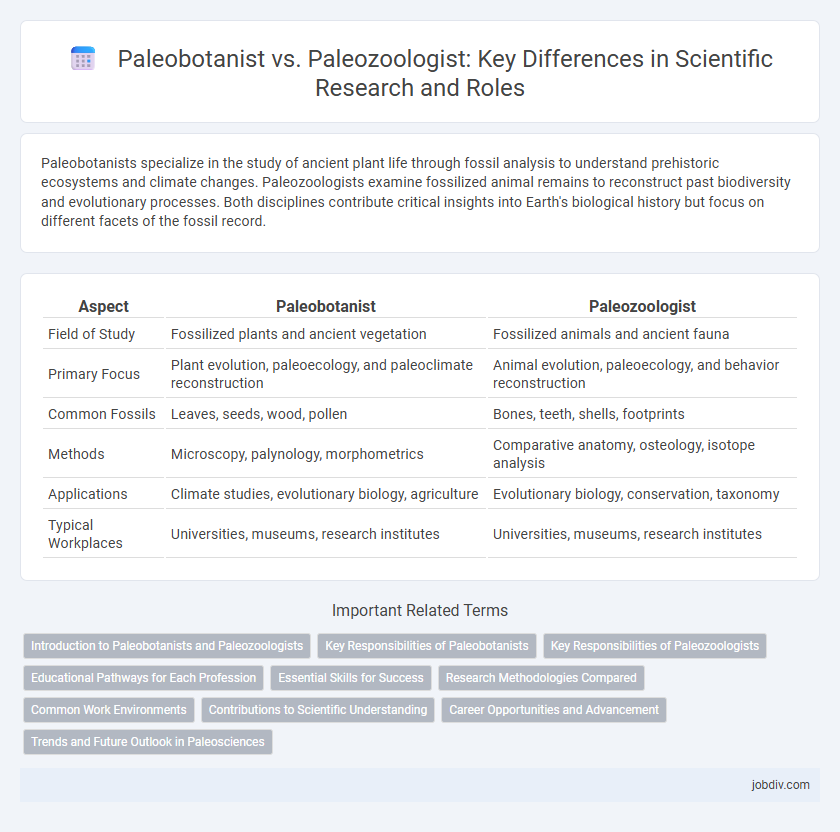Paleobotanists specialize in the study of ancient plant life through fossil analysis to understand prehistoric ecosystems and climate changes. Paleozoologists examine fossilized animal remains to reconstruct past biodiversity and evolutionary processes. Both disciplines contribute critical insights into Earth's biological history but focus on different facets of the fossil record.
Table of Comparison
| Aspect | Paleobotanist | Paleozoologist |
|---|---|---|
| Field of Study | Fossilized plants and ancient vegetation | Fossilized animals and ancient fauna |
| Primary Focus | Plant evolution, paleoecology, and paleoclimate reconstruction | Animal evolution, paleoecology, and behavior reconstruction |
| Common Fossils | Leaves, seeds, wood, pollen | Bones, teeth, shells, footprints |
| Methods | Microscopy, palynology, morphometrics | Comparative anatomy, osteology, isotope analysis |
| Applications | Climate studies, evolutionary biology, agriculture | Evolutionary biology, conservation, taxonomy |
| Typical Workplaces | Universities, museums, research institutes | Universities, museums, research institutes |
Introduction to Paleobotanists and Paleozoologists
Paleobotanists specialize in studying fossilized plants, analyzing ancient vegetation to understand past climates and ecosystems, utilizing techniques such as palynology and macrofossil examination. Paleozoologists focus on fossilized animals, reconstructing extinct species' morphology, behavior, and evolutionary history through comparative anatomy and paleobiological methods. Both disciplines contribute critical insights into Earth's prehistoric biodiversity and environmental changes through fossil record interpretation.
Key Responsibilities of Paleobotanists
Paleobotanists analyze fossilized plant remains to reconstruct ancient ecosystems and understand evolutionary processes of prehistoric flora. They specialize in identifying plant species from various geological periods and interpreting environmental conditions based on paleobotanical evidence. Their research contributes to insights on climate change, plant diversity, and the co-evolution of plants and animals throughout Earth's history.
Key Responsibilities of Paleozoologists
Paleozoologists specialize in studying ancient animal life by analyzing fossilized remains, contributing to understanding evolutionary processes and past ecosystems. Their key responsibilities include excavating fossil specimens, identifying and classifying extinct species, and interpreting fossil evidence to reconstruct animal behavior and environmental conditions. They collaborate with geologists and paleobotanists to provide comprehensive insights into prehistoric biodiversity and ecological relationships.
Educational Pathways for Each Profession
Paleobotanists typically pursue a bachelor's degree in botany, biology, or geology followed by advanced studies specializing in paleobotany or paleontology, with emphasis on fossil plants and prehistoric vegetation. Paleozoologists often begin with a bachelor's degree in zoology, biology, or ecology, advancing through graduate programs focusing on fossil animals, vertebrate paleontology, or evolutionary biology. Both professions require strong backgrounds in geology and earth sciences, with fieldwork and laboratory research integral to their educational training.
Essential Skills for Success
Paleobotanists require expertise in fossil plant identification, microscopic analysis, and stratigraphy to reconstruct ancient vegetation and climate conditions. Paleozoologists must possess strong skills in comparative anatomy, fossil excavation, and behavioral inference to interpret extinct animal species and ecosystems. Both disciplines demand proficiency in geochronology and paleoenvironmental reconstruction to contextualize their findings within Earth's history.
Research Methodologies Compared
Paleobotanists primarily utilize microscopic analysis of fossilized plant material, including spores, pollen, and leaf imprints, to reconstruct ancient ecosystems and climate conditions. Paleozoologists rely heavily on comparative anatomy, using fossilized bones, teeth, and trace fossils, combined with advanced imaging techniques like CT scanning to understand extinct animal physiology and behavior. Both disciplines employ stratigraphic correlation and radiometric dating to establish chronological frameworks, but their specimen preparation and analytical tools differ significantly according to their distinct focus on plant or animal remains.
Common Work Environments
Paleobotanists and paleozoologists both frequently conduct research in natural history museums, universities, and government research institutions where they analyze fossilized plant and animal remains respectively. Fieldwork is essential for both disciplines, typically taking place in sedimentary rock formations, excavation sites, and ancient geological deposits to collect specimens. Laboratories equipped with microscopes, imaging technology, and dating instruments support detailed examination and data analysis crucial for reconstructing prehistoric ecosystems.
Contributions to Scientific Understanding
Paleobotanists contribute to scientific understanding by analyzing fossilized plants, revealing insights into ancient ecosystems, climate change, and plant evolution over millions of years. Paleozoologists examine fossilized animals to reconstruct past biodiversity, evolutionary processes, and environmental shifts through time. Both disciplines collaboratively enhance knowledge of prehistoric life and Earth's history by integrating botanical and zoological data.
Career Opportunities and Advancement
Paleobotanists primarily analyze fossilized plants to reconstruct ancient ecosystems, offering career opportunities in academic research, museum curation, and environmental consulting. Paleozoologists study fossilized animals, with career paths available in paleontology research institutions, natural history museums, and biotechnology firms focusing on evolutionary studies. Advancement in both fields depends on research publications, grants, and specialization in interdisciplinary techniques like geospatial analysis and molecular paleontology.
Trends and Future Outlook in Paleosciences
Paleobotanists are increasingly leveraging advanced imaging technologies and molecular analysis to reconstruct ancient plant ecosystems, driving innovations in understanding Earth's climatic history. Paleozoologists focus on integrating isotopic data and phylogenetic methods to refine the evolutionary timelines of extinct fauna, enhancing models of biodiversity shifts. Emerging interdisciplinary approaches, combining paleobotany and paleozoology with AI-driven data synthesis, promise deeper insights into paleoecological dynamics and extinction patterns in future paleosciences research.
Paleobotanist vs Paleozoologist Infographic

 jobdiv.com
jobdiv.com